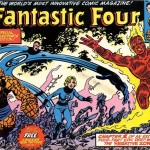What do Buddhism, the drug age, the automobile, and Pentecostalism have in common? In different ways, they have all influenced the current state of Christianity in North America. In her latest book, The Great Emergence, Phyllis Tickle explores the challenges to and changing nature of Christianity in the 21st century.
In The Great Emergence: How Christianity is Changing and Why, Tickle argues that every 500 years or so, the Church endures a giant rummage sale and breaks from entrenched institutional and doctrinal norms. We know the names of previous rummage sales well: he Great Reformation, he Great Schism, the Council of Chalcedon…. While this new shift is Tickle’s main focus (what it is, how it has come to be, and where it is taking us), she argues very forcefully that any attempts to understand it will be incomplete without an investigation into these other great previous rummage sales.
Tickle is also very aware that these rummage sales impact not only the Church, but the wider culture as well, influencing politics, economics, etc. At the same time, the impact on the Church is informed by extra-ecclesial factors. Science, technology, media, and, most recently, a transition from money as power to information as power are the common external influences. In fact, her study also reveals that these shifts take place in the other two Abrahamic faiths as well. However, for the purposes of this book, she focuses on the Great Emergence from a Christian standpoint and considers its religious nature over against other cultural or economic realities, although these too inform her work.
In each of these upheavals, including this one, Tickle argues: “First, a new, more vital form of Christianity does indeed emerge. Second, the organized expression of Christianity which up until then had been the dominant one is reconstituted into a more pure and less ossified expression of its former self. […] The third result is of equal, if not greater, significance, though. That is, every time the incrustations of an overly established Christianity have broken open, the faith has spread–and been spread–dramatically into new geographic and demographic areas […]” (17). Shortly thereafter, she attempts to allay any fears: “”It is especially important to remember that no standing form of organized Christian faith has ever been destroyed by one of our semi-millennial eruptions. Instead, each simply has lost hegemony or pride of place to the new and not-yet-organized form that was birthing” (27). What we should fear, however, “with all our hearts and minds and souls [is] the pattern of bloodiness that has in the past characterized the separation of innovators and re-traditioners from one another” (58).
(Post)Modernity has brought countless questions. Tickle draws out two that are especially pertinent for this latest shift: “The two overarching, but complimentary questions of the Great Emergence are: (1) What is human consciousness and/or the humanness of the human? and (2) What is the relation of all religions to one another–or, put another way, how can we live responsibly as devout and faithful adherents of one religion in a world of many religions” (73). One need not think long about the various technologies and scientific advances that have given rise to these questions and complicated them almost over-night.
Though she never devotes any extended analysis to it, throughout her text, Tickle is keenly aware of the roles that technology and new forms of social media play in the Great Emergence. Drawing parallels to the Great Reformation, she writes, “It would, quite literally, be impossible to exaggerate the central importance to the Great Emergence of the Internet and the World Wide Web. By the same token and in absolutely analogous ways, it would be impossible to overstate the importance of the Great Reformation of the invention of the printing press by Gutenberg in 1440 […]” (53). The advent of television and radio, decades before the Internet, sounded the first warning shot, and Tickle recognizes that the Bill Moyers/Joseph Campbell PBS series represented a major challenge from the pew to the pulpit. Taken together, these technologies that draw us closer together and provide us with a wealth of information pose great challenges to the Church. Tickle adds, “The computer, opening up as it does, the whole of humankind’s bank of collective information, enables the priesthood of all believers in ways the Reformation could never have envisioned. It also, however, opens up all that information to anybody, but without the traditional restraints of vetting or jurying […]” (107).
Tickle also devotes an entire chapter filled with graphs that attempt to image the appearance of denominations in 21st century Christianity. Her first graph starts off with four quadrants but then spirals out of control as each quadrant overlaps the other. Tickle adds, “What is happening is something much closer to what mathematicians and physicists call network theory. That is, a vital whole–in this case, the Church, capital C–is not really a ‘thing’ or entity so much as it is a network in exactly the same way that the Internet or the World Wide Web or, for that matter, gene regulatory and metabolic networks are not ‘things’ or entities. […] The end result of this understanding of dynamic structure is the realization that no one of the member parts or connecting networks has the whole or entire ‘truth’ of anything, either as such and/or when independent of the others” (152). Lest we think this is some post-modern invention, we must listen for the echoes of Paul who talked about the church as the body of Christ with each member blessed with different talents and gifts.
Thus, like few other “liberal” theologians, Tickle recognizes the value in the conservative, fundamentalist Christians who often react so dogmatically and occasionally violently against the challenges that face the church. One cannot read Tickle’s book and not get the sense that these reactionaries are dead or dying and just don’t know it yet. Yet Tickle herself does not give up hope on them or abandon them. She writes, “In the Great Emergence, reacting Christians are the ballast. However unattractive they may seem to be to other of their fellow Christians and however unattractive nonreacting Christians may seem to be to them […]. If the boat is not to tip and swamp, the ballast that forestalls too hasty a set of movements in a stormy sea must be there. One of the great dangers of what North America is going through is that some of her Christians, of whatever stripe, may cease to honor and accept the necessary function of all her Christians” (138-139). In the end, Tickle is well aware that there is no one way to respond to the challenges that face the Church, but respond we must. She recognizes that even the Emergent Church, what some people might see as a monolithic entity, is far from that as it has taken on at least two main competing theological strands.
Though Tickle’s book is relatively brief, it is packed with thoughtful analyses of the past and the present and not at all short on controversial points that have and will no doubt continue to spark energetic discussions in congregations, classrooms, and bars across the country. I found her recognition of the importance of technology and digital media especially helpful and a welcome inclusion in a field where they are often ignored. It would be great to see her devote an entire work to that. Tickle’s book is a must-read for religious and non-religious audiences alike, but especially for those of us still interested in participating in the life of the Church.
















